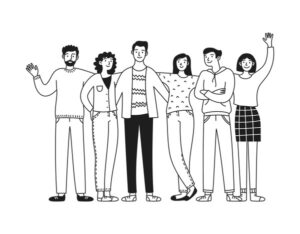Amina’s story begins with loss, marked by her husband Bayo’s passing and the grief and isolation that follow. She is left with two young children, Kofi and Sisi, and the weight of widowhood, a role that brings social stigma in her village. According to tradition, Amina is expected to live in seclusion, marked by her black clothing and shaved head, and she faces daily whispers and judgment from villagers who view her as a harbinger of misfortune. Even in her sorrow, Amina senses the disconnection, both from her former community and from the vibrant self she once knew.
One evening, as Amina was returning from the village well with a bucket of water on her head, she felt the prying eyes of the villagers on her. Two women, Oluchi and Fatima, stood nearby, whispering to each other.
“It’s such a shame, isn’t it?” Oluchi murmured, just loud enough for Amina to hear. “They say she brought bad fortune to her husband.”
Fatima shook her head, casting a sympathetic look. “And what can she do now? She has no man to provide for her.”
Amina’s heart clenched. Each word felt like a lash, a reminder of her isolation. She quickened her pace, desperate to escape the stares and murmurs that seemed to follow her every step. Once home, she sat in silence, her children playing quietly nearby. She wanted to cry out, to let the pain flow, but she held back. Her children didn’t need to see her suffering; they already bore enough of her sorrow.
As night fell, Amina lay in the dim glow of her lantern, thoughts racing. She wondered if she’d ever be accepted again, if she’d ever regain the respect she once had in the village. The weight of widowhood felt unbearable, as though she were carrying an invisible burden that no one else could see.
Days turned into weeks, and Amina continued to endure her daily trials in silence. But one day, a meeting of the village elders was called. Baba Olumo, the eldest of them all, was a respected figure with a gentle heart. He had known Amina’s late husband, Bayo, and had often admired his dedication to his family.
As the elders gathered under the shade of a large baobab tree in the village center, Baba Olumo raised his voice, calling for attention. “My people,” he began, “we have traditions that we hold dear, customs passed down by our ancestors. But we also have a responsibility to each other, as neighbors, as family.”
Some elders nodded in agreement, but a few others looked doubtful.
“Baba,” one elder named Chukwuma spoke up, “widows have always been taken care of by their own families. It is not for the village to bear that burden.”
“But what if her family is struggling too?” Baba Olumo replied, his tone calm but resolute. “Are we not one family here? If one of us suffers, do we not all suffer?”
The words hung in the air, sinking into the minds of the villagers who had gathered to listen. Baba Olumo then proposed a simple idea: each family could contribute something small—a bowl of maize, a few yams, a day’s labor to repair Amina’s roof. It would require little from each person, yet together, it could change Amina’s life.
Reluctantly, some villagers agreed. Others, inspired by Baba Olumo’s wisdom, nodded in solidarity.
The next morning, Amina was tending to her small garden when she heard a gentle knock at her door. She opened it to find Mama Zainab, an older woman who had once been a close friend but had distanced herself after Bayo’s passing. In her hands, Mama Zainab held a basket filled with yams and cassava.
“Amina,” she said softly, avoiding her gaze, “I brought these for you. I know… I know it’s not much, but I hope it helps.”
Amina was taken aback, her throat tightening with emotion. “Thank you, Mama Zainab,” she whispered, barely able to hold back tears.
As the days passed, other villagers began to show up, each bringing small but meaningful gifts. One brought clothes for Kofi and Sisi, another offered to repair the leaking thatch roof, while others simply sat with Amina, providing companionship and easing her loneliness.
Amina felt her heart swell with gratitude, her grief slowly softening in the warmth of her community’s support. Each gesture, no matter how small, was a lifeline, a reminder that she was not alone.
With her basic needs met, Amina began to feel a renewed sense of strength. She decided to cultivate a small plot of land that had been left uncultivated by the village well. Although she had no experience in farming, some villagers offered to help her plant seeds, till the soil, and harvest the crops. Slowly, she began to grow vegetables—okra, tomatoes, and peppers—that she could sell at the local market.
Her first day at the market was nerve-wracking. She arranged her small harvest on a mat, uncertain if anyone would buy from a widow. But as the day wore on, familiar faces from the village stopped by to purchase her produce, offering words of encouragement and even helping her sell when she felt overwhelmed.
The market became her sanctuary, a place where she felt valued again. With each sale, Amina felt her confidence grow, the sting of isolation fading into something resembling hope.
Amina’s journey from isolation to empowerment serves as a beacon for widows everywhere and a reminder to each of us of the importance of community. Her story asks us to look beyond tradition, to see the humanity in each person, and to reach out to those in need.
This tale is more than just a story; it is a call to action. For in every community, there are widows like Amina—women who have lost not just their husbands but their place in society. They carry burdens of grief, of stigma, of survival in a world that often overlooks them. As readers, as neighbors, we are challenged to ask ourselves: What can we do to help? How can we bring hope and comfort to those who suffer in silence?
Let Amina’s story be a reminder that even the smallest act of kindness can change a life, that we all hold the power to lift each other up, to create a village where no one is left behind.




2 thoughts on “The Village That Raised Hope”
The story of Amina is just a reminder of what obstacles faces women in society, this kind of pressure that is established since the day we are born, we are expected to be fragile but not too much, be courageous but not have a different opinion of male and be for everyone. That is how we can intervene as leaders, we don’t simply want to create a positive impact on the community, we want their voices to be spread, we want them to have the freedom of express what are their desires and make them into a reality, she has to find refugee in associations that gives the correct emotional, social and economical support for the raise of her children .
@ Susana Ospina,
The story of Amina highlights the deep-rooted pressures and societal expectations placed on women from birth. It serves as a call to action for us as leaders to not only challenge these norms but also amplify women’s voices, ensuring they have the freedom and resources to pursue their dreams. By fostering emotional, social, and economic support through inclusive associations, we can create a future where every woman has the power to transform her desires into reality and thrive despite obstacles. Together, we can build a society that values and uplifts everyone equally.